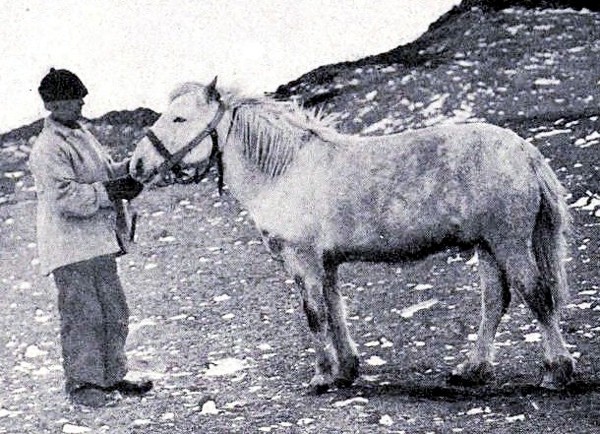
Shackleton’s ponies and their unusual diet
I was recently reading Sir Ernest Shackleton’s account of his ‘Nimrod’ expedition of 1907-09 (Heart of the Antarctic by Sir Ernest Shackleton, 1909) and came across his account of the feed that they were giving the ponies that they had taken with them to pull the sledges.
He says ‘I had secured in London twenty tons of maize and ten hundredweight of compressed Maujee ration for the feeding of the ponies in the Antarctic…and the ponies were very fond of it’, they would ‘eat that up before touching the maize’
He and his men set off on their quest for the South Pole with the ponies and he states ‘The food for the ponies on the march consisted of maize and Maujee ration, with a little of the Australian compressed fodder’ and later when they returned to their camp after climbing Mount Hope ‘We were rather tired and very hungry when at 7pm we reached our camp. After a good dinner, and a cupful of Maujee ration in the hoosh [stew/soup] as an extra, we turned in’
So Maujee ration was edible by horse and man. But what was it?
According to Shackleton ‘This ration consists of dried beef, carrots, milk, currants and sugar, and it provides a large amount of nourishment with comparatively little weight’.
So it had meat in it which I find bizarre, although it seems that the ponies thrived on it. Maujee rations were a special equine (horse) pemmican developed at Aldershot, one of England’s premiere military establishments.
Frederick George Jackson, who crossed Siberia in winter on horseback’ recalled the diet of his favourite horse ‘Blackie’, ‘In addition to her regular feed of Spratt dog biscuits and hay, she shares the scraps left from our meals with the dogs, and very frequently helps herself to their polar bear meat, and shows a fondness for picking at bird skins lying around the hut.”. ‘[She] appears to be doing very well on her miscellaneous diet’. (A Thousand Days in the Arctic by Frederick George Jackson, 1899.)
It was Jackson who encouraged Shackleton to use ponies in his bid to reach the South Pole and so, taking this advice, he would eventually take ten Manchurian ponies with him on his quest, four of which set out on the polar journey.
Though of mixed usefulness in pulling the heavy sledges they eventually succumbed to the hardships of the journey and three were shot for food after they could go no further. The last one, Socks, fell into a crevasse.
There were other examples of horses eating meat in Antarctica, namely in the classic book by Apsley Cherry-Garrard (The Worst Journey in the World, 1922) who wrote
“One of our ponies, Snippets, would eat blubber and so far as I know it agreed with him,”
Also on the German Filchner expedition one of the horses, Stasi, happily ate dried fish and raw seal-meat. Towards the opposite side of the Earth in the Arctic some horses were also known to have eaten Polar Bear meat
Rather amazing when you consider that meat doesn’t seem to be the diet horses evolved to eat and look at what happens when you feed somewhat unnatural foods to animals. The development of Mad Cow’s disease was caused by feeding remains of other cattle or scrapie-infected sheep products to cows.
I don’t know why the horses developed a liking for meat, perhaps the taste was covered by the other ingredients in the Maujee ration though that doesn’t explain the other horses that had no Maujee but ate blubber, seal or polar bear meat, and fish.
Some suggest that extreme cold leads to a craving for fat and protein in horses but I’m not convinced. Hopefully the mystery will be solved one day.
This short, silent film shows Shackleton’s departure from Lyttleton, New Zealand for Antarctica in 1908 and has a section showing the ponies and dogs being loaded on the ship (there is no sound and the horses appear at the 1:57 mark).
